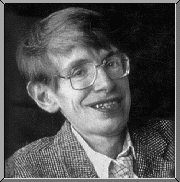 Stephen
William Hawking was born in Oxford, England, on
January 8, 1942. He studied physics at Oxford University, then
completed his Ph.D at Cambridge University in the field of
theoretical physics. In 1979 he was appointed Lucasian Professor of
Mathematics at Cambridge, a position once held by Sir Isaac
Newton.
Stephen
William Hawking was born in Oxford, England, on
January 8, 1942. He studied physics at Oxford University, then
completed his Ph.D at Cambridge University in the field of
theoretical physics. In 1979 he was appointed Lucasian Professor of
Mathematics at Cambridge, a position once held by Sir Isaac
Newton.
Hawking startled the worlds of mathematics and physics in 1974 with his discovery that black holes emit radiation. This fact was contrary to all the prevailing theories at the time, including Albert Einstein's General Theory of Relativity. In 1983 he published, along with Dr.James Hartle, the "no boundary theory" of the universe, another radical departure from conventional thought. The theory proposes that the universe is infinite, having no beginning or end, either physically or in time. Hawking has authored numerous books, including his 1988 bestseller, A Brief History of Time.
But perhaps even more noteworthy than his long list of accomplishments is the fact that Stephen Hawking has done these things while severely disabled. He suffers from the progressive neurological disease ALS, or amytropic lateral sclerosis. Hawking as been confined to a wheelchair for almost two decades, able to move only a few fingers. He communicates with the aid of a computer and a voice synthesizer. In a 1996 interview Dr. Hawking noted, "My body may be confined to this chair. But with the Internet my mind can go to the ends of the earth."
Page created by: David L. Putney
Bruen, Bob. Bibliography for Stephen Hawking. [Online]. Bruen, B. (Webmaster). Available http://www.tiac.net/users/bruen/hawking-bib.html
Dondaldson, Nicholas. The Stephen Hawking Page. [Online]. Donaldson, N. (Webmaster). Available http://www.psyclops.com/hawking/
Ferguson, K. (1991). Stephen Hawking: Quest for a Theory of the Universe. New York: Bantam Books.
Hawking, S. W. (1988). A Brief History of Time. New York: Bantam Books.
Hawking, S. W. (1993). Black Holes and Baby Universes and Other Essays. New York: Bantam Books.
McDaniel, M. (1994). Stephen Hawking: Revolutionary Physicist. New York: Chelsea House.
Sakurai, G. (1996). Stephen Hawking: Understanding the Universe. New York: Children's Press.
Sheridan, S. (1991). Stephen Hawking: Unlocking the Universe. Minneapolis, MN: Dillon Press.